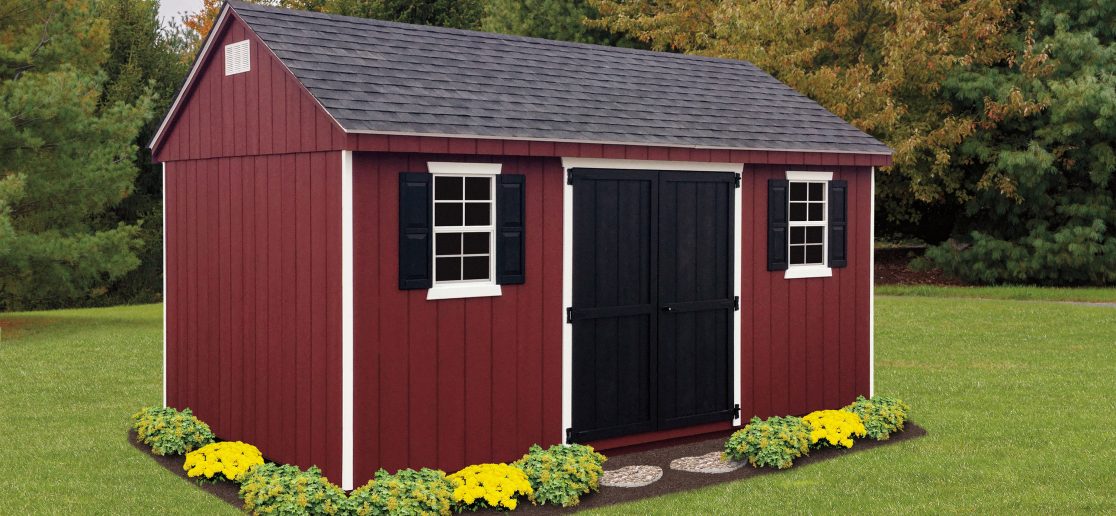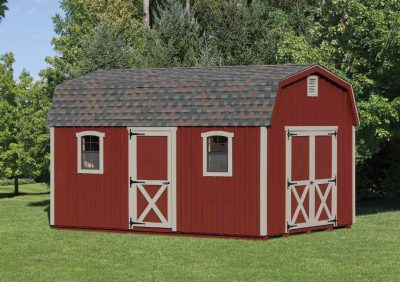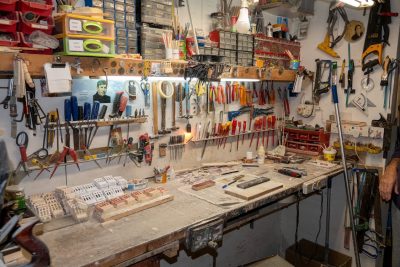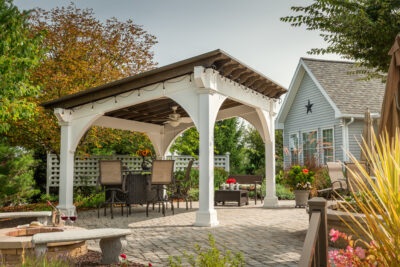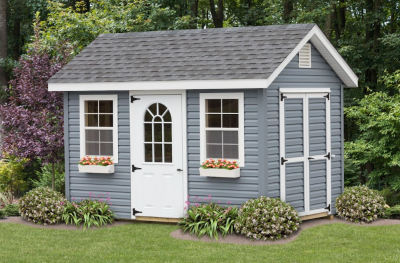Sheds are great structures to store lawn equipment or create additional functional living spaces for your home. When setting up your shed’s interior, keep in mind that how you plan to use it can determine if it needs to be insulated or not. There are multiple different types of insulation you can use for your shed. Finding the right one to use depends on budget, ease of installation, R-value, and what you want to use your shed for. Here’s how to find the right insulation for your shed.
Why You Should Insulate Your Shed
With Glick Structures, you can create a custom shed fit for your needs, or browse our inventory of completed structures that can be shipped directly to you. Once your shed is delivered, decide how you want to insulate it before moving your belongings inside. Insulating your shed will keep the structure climate-controlled and protect your belongings inside. It will minimize the amount of moisture seeping into the shed and provide comfort during hot or cold weather by keeping the shed at a mild temperature. The amount of insulation you may need varies depending on the climate you live in. If you live in a place where there are more extreme summers and winters, like Pennsylvania, it would be best to insulate your whole shed. If you live in a more tame climate, then you may only have to insulate parts of your shed. Determine the weather patterns of where you live to find an efficient insulation material that will work best for you. Insulating your shed is important if you want to use it for recreational purposes. If you are using your shed solely as a lawn equipment storage, then full insulation is not necessary, just enough to protect your belongings from excess heat, cold, and moisture. If you plan on using your shed as a home office, workshop, or playroom, the walls, door, and roof should all be insulated.
What is the R-Value?
Insulation materials have what is called an R-value to measure how well the material resists heat conducting through the insulation. It is calculated by dividing the thickness of the insulation by its thermal conductivity. If the R-value is high, it means that the piece has high thermal resistance and can better withstand extreme temperatures. Most people would think that the thickness of the insulation should be the most considered when buying, but the R-value will measure if an insulation piece is right for your shed in the climate you live in. The R-value is the most important aspect to consider when looking at insulation pieces so you can find the most appropriate material that will keep your shed warm.
Types of Insulation for Sheds
Fiberglass Insulation
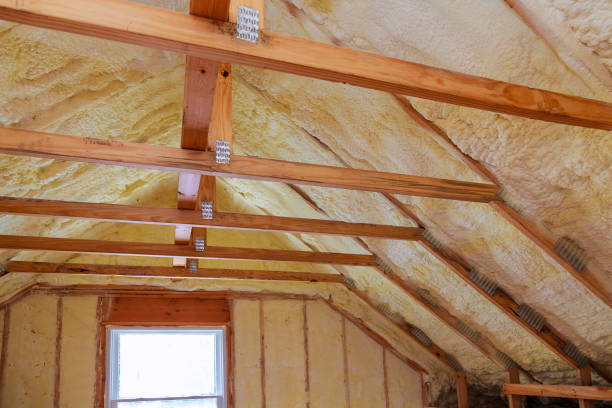
Fiberglass insulation is made up of recycled glass that is spun into fine fibers. They can be used in batt, loose-fill, or rigid-board insulation, but batt insulation is the most common use for fiberglass. Fiberglass reduces the speed with which heat and cold flow through the shed, evening out the temperature inside. This environmentally friendly option allows for energy efficiency, is fire-retardant, and is easy to install. This material is on the more affordable side, with the cost of installation being between $.80 to $1.64 per square foot. Fiberglass has a decent R-value, ranging from 3.1-3.4 per inch. This option is best to use if you plan to use your shed as a recreational space; it offers noise cancellation allowing you to use your shed as a music or art room. The downside to this insulation method is that it doesn’t perform well with high humidity levels, which can bring more moisture into the shed causing mildew and mold to grow. Fiberglass also attracts rodents, as the fluffy material can be chewed through and used to create a warm nest to live in.
Spray Foam Insulation
Spray foam insulation is made by mixing polyol resin and isocyanate to fully seal a structure. This insulator will get into all the nooks and crannies in your shed and seal the floor, walls, and ceiling to restrict air movement. There are two types of spray foam insulation – open-cell and closed-cell. Open-cell spray foam consists of small bubbles (cells) that are left open, making the foam more flexible and soft. Open-cell foam expands after application, allowing it to insulate any cracks in the shed. Closed-cell spray foam is a denser, more stable option, with the cells being closed and pressed together to restrict moisture and airflow. This option is more dense and stable than open-cell foam, making the shed more sturdy.
The R-value of spray foam insulation also depends on the type you buy. Open-cell has an R-value of 3.5-3.6 per inch and closed-cell has an R-value of 6-6.5 per inch. This method of insulation is better to be completed by a professional, as they will have the appropriate tools and training to safely install it. Since it should be installed professionally and can take a long time, there is a high initial cost for installation. For both open-cell and closed-cell spray foam, the cost for installation ranges between $1.50-$4.90 per square foot. For the cost of the material itself, open-cell foam is $0.44-$0.65 per square foot and closed-cell foam is $1-$1.50 per square foot. A downside to this method is direct contact with the material can irritate the eyes, skin, and respiratory system.
Blown-In Cellulose Insulation
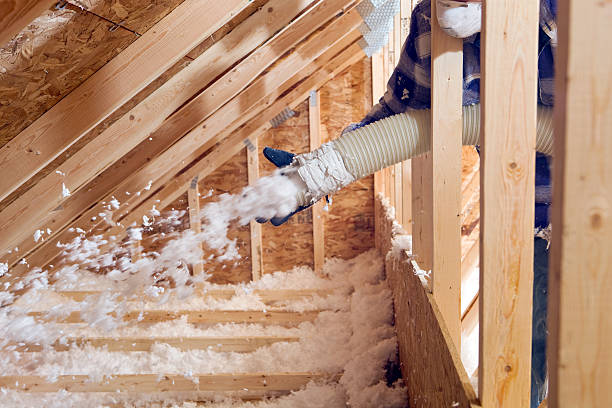
Blown-in cellulose insulation is a dense loose-fill material that is usually recycled paper or wood-based with a similar look and feel to feathers. The material is blown into a wall’s empty spaces to slow the flow of hot and cold air in the shed. Cellulose has boric acid in it, which will deter insects from entering your shed. The R-value of blown-in cellulose ranges from 3.2-3.9 per inch. Similar to fiberglass, blown-in cellulose is more affordable, the cost for the material ranges between $1-$1.50 per square foot. Installing this insulation requires special equipment that can be difficult to operate yourself, so it is better to have this done by a professional. The cost for professional insulation ranges from $40-70 per hour. This method is great for filling in hard-to-reach gaps in your shed and for re-insulation as the material can be used over other insulation materials, but it does not perform as well in high-moisture conditions. If you live in an area with high humidity levels, this option may not be right for you as the material will absorb the water.
Rigid Foam Insulation
Rigid foam insulation is foam boards that are stronger than batt and blown-in insulation as they won’t shift out of place. They provide thermal insulation, vapor control, and moisture control, which is great for people who are looking to build a wooden shed. There are three types of rigid foam insulation:
Expanded Polystyrene (EPS): This material is made by expanding polystyrene beads into foam with steam. It is the most affordable option, but if you live in a high-moisture environment it will need a moisture-resistant coating. The R-value for this material ranges from 3.6-4.2 per inch.
Extruded Polystyrene (XPS): XPS also uses polystyrene beads, but they are extruded through a die with additives before they expand into the foam boards. This option has better moisture resistance than EPS, is more durable, and has higher density. It costs more than EPS but has an R-value of 5 per inch. A popular brand of XPS is Styrofoam.
Polyisocyanurate (ISO): This material is made by the chemical reaction of mixing MDI, polyol, and additives and then laminating it to form foam boards. This option uses recycled materials, is non-flammable, and is less toxic than other insulation types. This option is eco-friendly, making it the most expensive option of the three. It has the highest R-value at 6.5 per inch, but this material is not water resistant, it will absorb water instead.
The foam material provides a warm shelter for rodents, but since it is stronger and denser than other insulation options rodents are likely to find different shelter. The boards can be easily cut and glued to the shed wall with construction adhesive, meaning you can install it without professional help. This material has the highest R-values in the list, making it the best option for thermal resistance.
Mineral/Stone Wool Insulation
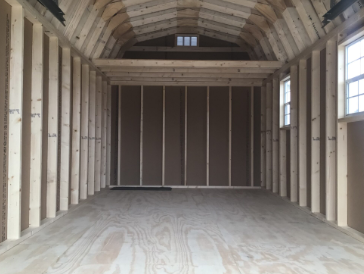
Mineral wool insulation (also called stone wool) is a material that can be cut and placed in between the studs in the shed walls. It is similar to fiberglass but is more dense and stiff in comparison. The material is fiber-based and uses a combination of melted slag and stone that is spun into fibers. This material has a high resistance to heat and great thermal conductivity but doesn’t store as much thermal energy as other insulation methods. The material is not flammable, reduces noise, and works well in moisture-prone areas, making it a great insulation option if you live in a high-humidity area like Pennsylvania. The R-value for mineral wool ranges from 3.1-3.4 per inch, and the general price range is around $0.62-$1.10 per square foot. While installing insulation is better done by a professional, installing mineral wool is a quick and easy process that you can do yourself if you are on a budget. If installing on your own, be sure to wear gloves as constant contact with the material can irritate your skin.
Foil-Backed Bubble Wrap Insulation
Foil-backed bubble wrap insulation is more of a thermal blocker and radiation protectant than an insulator. Still, it is the most budget-friendly option and you do not need a professional to install it. It uses two pieces of foil with air bubbles in between, which creates an air gap in the shed to regulate hot and cold temperatures. It acts as a mirror and reflects the heat to go back outside, keeping the inside cool. This option is good for wooden sheds as you can staple the sheets to the shed’s frame. It has a very low R-value, only 1-1.1, but the prices range from $50-$300 for one roll of insulation. Foil-backed bubble wrap is easy to install; all you need to do is cut the sheets to fit, staple them to the shed’s frame, and cover them with plywood sheets to improve the appearance of the shed and keep rodents from getting into it. This option would work well if you plan to use your shed as a storage space, as it won’t need full insulation.
All of these materials are good insulators to keep your shed climate-controlled in the summer and winter. Your best option depends on your climate, but generally rigid board, spray foam, and fiberglass are the best insulators. Glick Structures typically insulate your shed’s walls and ceiling with Fiberglass and use Rigid Foam in the floor, but we can customize your insulation method to better fit your needs. There is plenty of flexibility with Glick, we can install Spray Foam or Bubble Wrap insulation as well. Have Glick Structures build your dream shed, then decide which insulator will align with your plans for the shed and the temperature you live in.
